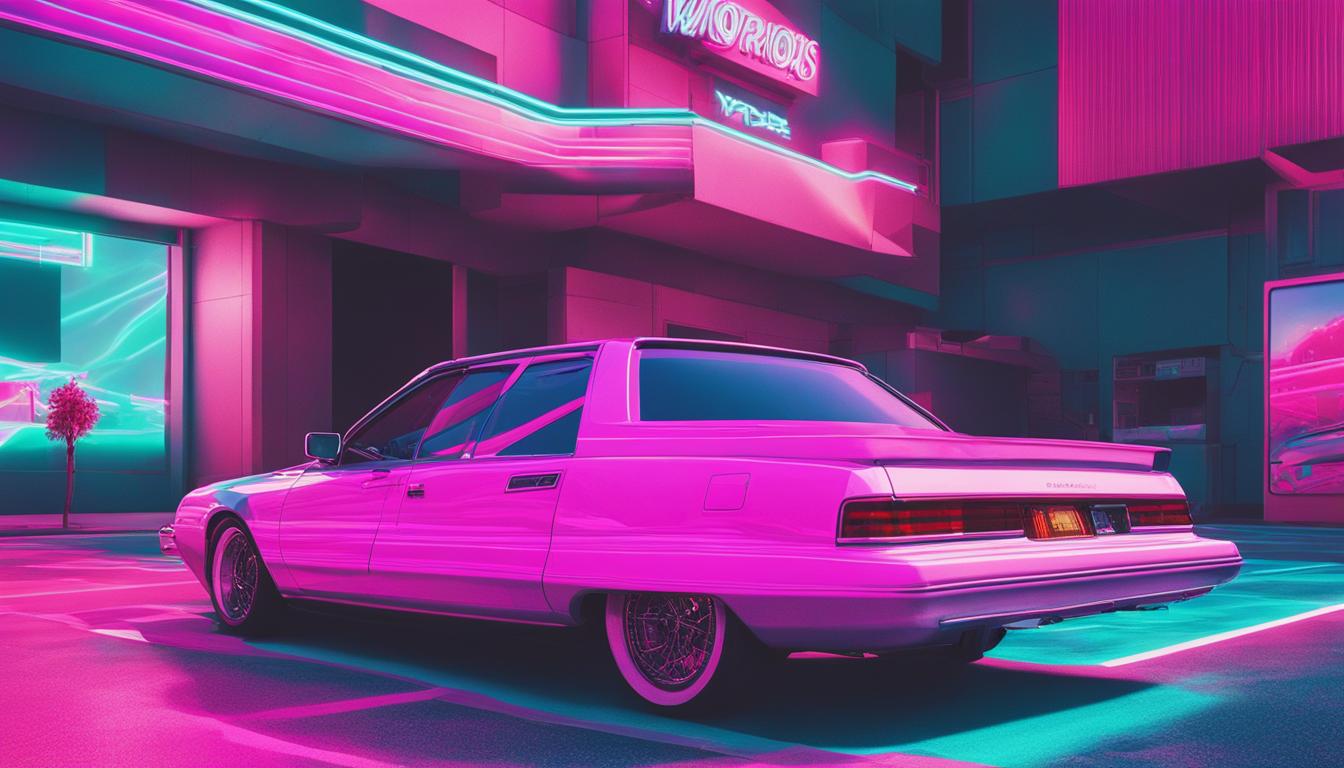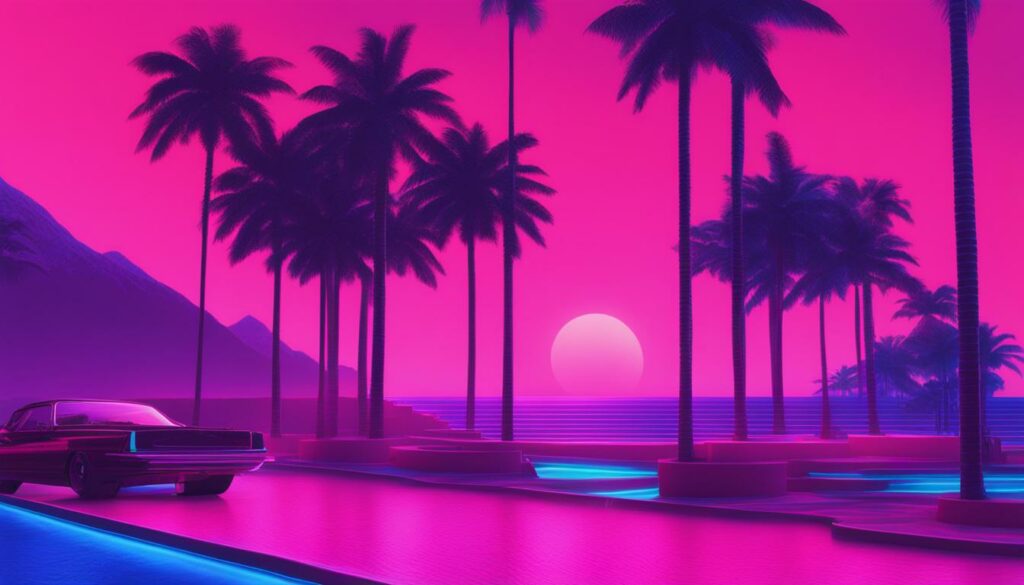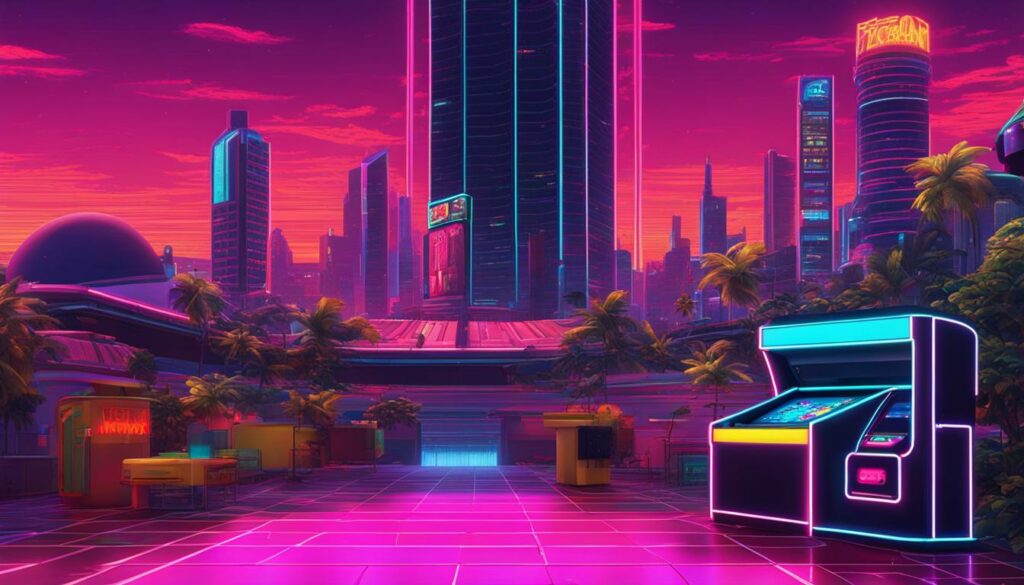No products in the cart.

Welcome to the world of vaporwave art, where the past and the future merge in a mesmerizing blend of aesthetics. This unique genre, born out of the early 2010s, captivates with its retro-inspired visuals and digital charm. Vaporwave art taps into the nostalgia of the 80s and 90s, while also embracing the futuristic elements of the internet era. With its distinct style and cultural impact, vaporwave has become a captivating part of the art world.
Vaporwave originated as a unique and ironic variant of chillwave, gaining momentum in the early 2010s. It was influenced by the hypnagogic pop movement and the underground digital music and art scenes of the time. Artists such as James Ferraro, Daniel Lopatin, and Ramona Xavier played a significant role in pioneering the genre and shaping its distinct sound and aesthetic.
Hypnagogic pop, with its dreamy and nostalgic atmosphere, laid the foundation for vaporwave’s exploration of retro-inspired sounds and visuals. The genre embraced post-internet motifs and subverted consumer capitalist culture, often incorporating nostalgic and surrealist elements from previous decades. Tumblr seapunk, a digital subculture that emerged in the early 2010s, also had an influence on vaporwave, particularly in terms of its aesthetics.
Vaporwave emerged as a tongue-in-cheek critique of consumer culture and a reflection of the internet age. Its origins can be traced back to the experimental and subversive music scenes of the early 2010s, where artists pushed the boundaries of electronic music and visual art.
Platforms like Last.fm, Reddit, and 4chan played a crucial role in the early development and popularization of vaporwave. Many artists released music under online pseudonyms, creating an air of mystery and anonymity. The genre’s growth was further fueled by the internet’s ability to connect like-minded individuals and foster a sense of community among vaporwave enthusiasts. Over time, subgenres and offshoots of vaporwave emerged, including future funk, mallsoft, and hardvapour, each with its own unique blend of influences and characteristics.
| Influences | Description |
|---|---|
| Hypnagogic pop | A dreamy and nostalgic subgenre of pop music that laid the foundation for vaporwave’s retro-inspired sound and aesthetic. |
| Chillwave | A genre characterized by its laid-back and lo-fi sound, which influenced the slow and atmospheric nature of vaporwave. |
| Post-internet motifs | The incorporation of internet-related visuals and themes, reflecting the influence of digital culture and the online world. |
| Underground digital music | The experimental and subversive music scenes of the early 2010s, which pushed the boundaries of electronic music and art. |
| Tumblr seapunk | A digital subculture that emerged in the early 2010s, known for its neon aesthetic and aquatic imagery, which influenced vaporwave’s visuals. |
The origins and influences of vaporwave have shaped it into a genre that defies traditional categorization and continues to evolve, captivating audiences with its nostalgic and futuristic allure.
Vaporwave is a hyper-specific microgenre that blurs the line between electronic music and visual art. It is characterized by its slowed-down samples, chopped and screwed techniques, repetition, and heavy use of reverb. The genre’s creation often relies on the manipulation of existing music through audio editing software and production techniques. The visual aesthetic of vaporwave includes the use of early internet imagery, glitch art, anime, Greek sculptures, 3D-rendered objects, and cyberpunk elements.

The art style of vaporwave encompasses various visual accoutrements that contribute to its unique aesthetic. The inclusion of early internet imagery, such as old computer interfaces, pixelated graphics, and retro website designs, evokes a sense of nostalgia for the early days of the internet. Glitch art, characterized by distorted or scrambled images, adds an element of digital malfunction and imperfection to the visual composition.
Repetition is another key characteristic of vaporwave, both in its music and visual art. This repetition creates a hypnotic and mesmerizing effect, drawing the listener or viewer into a dreamlike state. The heavy use of reverb enhances this dreamy atmosphere, giving the music and visuals a spacious and ethereal quality.
“Vaporwave often manipulates existing music by slowing it down, pitch-shifting it, and applying various effects to create a distorted and otherworldly sound.” – Vaporwave artist
One of the defining techniques in vaporwave is the use of chopped and screwed techniques. Originating from hip-hop and influenced by DJ Screw’s signature style, chopped and screwed involves slowing down the tempo of a track and manipulating its pitch. This technique gives the music a warped and distorted quality, contributing to the dreamy and nostalgic atmosphere of vaporwave.
In conclusion, vaporwave is a microgenre that seamlessly fuses electronic music and visual art. Its characteristics include slowed-down samples, chopped and screwed techniques, repetition, and a heavy use of reverb. The visual aesthetic of vaporwave incorporates early internet imagery, glitch art, anime, Greek sculptures, 3D-rendered objects, and cyberpunk elements. The genre’s unique art style and sound have made vaporwave a captivating and influential movement in contemporary music and art.
Vaporwave art is known for its distinctive visual style that combines elements of retro aesthetics with futuristic imagery. Drawing inspiration from a variety of sources, vaporwave artists create captivating visuals that evoke a sense of nostalgia and explore themes such as consumerism and the digital age. Let’s take a closer look at some of the key visuals and inspirations in vaporwave art.
One of the major influences on vaporwave art is the Memphis Group, an Italian design and architecture collective from the 1980s. The group’s bold and eclectic style, characterized by vibrant colors, geometric shapes, and playful patterns, has become synonymous with the visual aesthetic of vaporwave. The use of Memphis-inspired elements in vaporwave art adds a sense of retro-futurism and creates a visually striking contrast.
Another visual inspiration for vaporwave art is the nostalgic imagery found in Nintendo 64 game backgrounds. The pixelated graphics, vibrant colors, and surreal landscapes of these games have become iconic symbols of the 90s gaming era. Vaporwave artists often incorporate these elements into their artwork, creating a sense of nostalgia and a connection to the digital culture of the past.
Unusual and unexpected visuals are also common in vaporwave art. Pink dolphins, a symbol of rarity and tranquility, are often depicted in vaporwave artwork, adding a dreamlike and ethereal quality to the visuals. Additionally, Greek statues, with their classical beauty and timeless appeal, are frequently used in vaporwave art to create a sense of grandeur and cultural references.
Consumerism and the imagery associated with it play a significant role in vaporwave art. The use of brand logos, advertisements, and product packaging reflects the critique of consumer culture and the obsession with material possessions. Windows 95, with its iconic interface and aesthetic, is often referenced in vaporwave art, representing a bygone era of technological innovation and the rise of the digital age.
| Visual Inspirations | Description |
|---|---|
| The Memphis Group | An Italian design and architecture collective known for their bold and eclectic style characterized by vibrant colors, geometric shapes, and playful patterns. |
| Nintendo 64 Game Backgrounds | Nostalgic imagery from the 90s gaming era, featuring pixelated graphics, vibrant colors, and surreal landscapes. |
| Pink Dolphins | Symbols of rarity and tranquility, pink dolphins add a dreamlike and ethereal quality to vaporwave art. |
| Greek Statues | Classical beauty and cultural references are evoked through the use of Greek statues in vaporwave art. |
| Consumerism and Windows 95 | Critique of consumer culture and the imagery associated with it, including brand logos, advertisements, and the iconic aesthetic of Windows 95. |
Vaporwave music is renowned for its unique approach to composition and sampling. Drawing heavily from 80s and 90s music, vaporwave artists incorporate elements of pop, smooth jazz, and Muzak into their tracks. The genre is characterized by its slowed-down samples, creating a dreamy and nostalgic atmosphere.
Sampling plays a key role in vaporwave, with artists manipulating existing music to create distinct and innovative sounds. By slowing down samples and altering them with effects, vaporwave artists give familiar tracks a fresh and ethereal quality. This technique not only pays homage to the original artists but also transforms the music into something entirely new.
While sampling is a significant component of vaporwave, some artists also create original compositions within the genre. This allows for even more experimentation and creativity, pushing the boundaries of what vaporwave can sound like. Whether through sampling or original composition, vaporwave music has captivated listeners with its unique blend of nostalgia and innovation.
The physical distribution of vaporwave music also adds to its appeal. Many vaporwave releases are available on cassette tapes and vinyl records, providing a tangible and retro experience for fans. This nostalgic format aligns perfectly with the genre’s aesthetic, creating a complete and immersive experience for listeners.
“Vaporwave music takes familiar sounds and transforms them into something completely new and captivating.” – Music critic
| Aspect | Description |
|---|---|
| Sampling | Using snippets of existing music to create new compositions |
| Slowed-down samples | Altering the speed of samples to create a dreamy and nostalgic atmosphere |
| Original compositions | Creating new music within the vaporwave genre |
| Cassette tapes and vinyl records | Physical formats that enhance the retro appeal of vaporwave music |
Vaporwave has exerted a strong influence on fashion and visual culture, particularly in the realm of streetwear. Its unique blend of retro and futuristic elements has inspired the design of clothing and accessories in the aesthetic fashion industry. Vaporwave fashion incorporates pastel colors, glitch effects, and logos from iconic brands, creating a distinctive and visually impactful style.
This vaporwave-inspired fashion trend often appropriates symbols and imagery associated with consumerism and nostalgia. Brands and designers draw from nostalgic imagery of the 80s and 90s, blending it with futuristic elements to create a sense of visual contrast. The result is a fashion style that resonates with individuals who appreciate the intersection of past and future, nostalgia and innovation.
| Key Elements of Vaporwave Fashion | Examples |
|---|---|
| Pastel Colors | Soft shades of pink, blue, and purple |
| Glitch Effects | Distorted and fragmented patterns |
| Logos from Iconic Brands | Brands like Coca-Cola and McDonald’s |
| 80s and 90s Nostalgia | References to retro technology, music, and pop culture |
The visual culture surrounding vaporwave extends beyond fashion and permeates various facets of contemporary art and design. Artists and creators have embraced the appropriation of symbols and imagery as a means of recontextualizing and critiquing consumer culture. Vaporwave’s nostalgic imagery and aesthetic appeal have become powerful tools for expressing social commentary and exploring the contradictions of contemporary society.
In conclusion, vaporwave’s impact on fashion and visual culture is undeniable. The genre’s distinct style has influenced streetwear and aesthetic fashion, with its unique blend of past and future aesthetics. The appropriation of symbols, nostalgic imagery, and diverse visual elements have made vaporwave an influential force in contemporary visual culture, providing a platform for creative expression and social critique.
Vaporwave aesthetics have found their way into various forms of media, including films, series, and video games. These works often embrace cyberpunk aesthetics and exhibit a retro-futuristic storytelling style that resonates with the vaporwave genre. With their vivid neon colors, glitch effects, and a blend of nostalgia and futurism, these pieces of media create a visually engaging experience for their audience. Let’s explore some notable examples:
One film that prominently features vaporwave aesthetics is “Drive” (2011), directed by Nicolas Winding Refn. The atmospheric cinematography, combined with the synth-heavy soundtrack reminiscent of 80s electronic music, creates a visual and auditory experience that aligns with the vaporwave ethos. Another notable film is “Blade Runner 2049” (2017), directed by Denis Villeneuve. This neo-noir sci-fi masterpiece incorporates cyberpunk elements, futuristic cityscapes, and a nostalgic nod to the original “Blade Runner” film, capturing the essence of the vaporwave aesthetic.
“Stranger Things” (2016-present), created by the Duffer Brothers, is a popular TV series that showcases vaporwave-inspired visuals. Set in the 1980s, the show captures the nostalgia of the era with its vibrant color palette and retro technology, while also incorporating elements of the supernatural and alternate dimensions. Another series that embraces vaporwave aesthetics is “Mr. Robot” (2015-2019), created by Sam Esmail. This cyberpunk thriller explores themes of hacking and corporate power, featuring a dark and gritty visual style that aligns with the futuristic and dystopian elements of vaporwave.
Video games have also embraced vaporwave aesthetics, with titles such as “Hotline Miami” (2012) and “VA-11 Hall-A: Cyberpunk Bartender Action” (2016). “Hotline Miami” combines fast-paced gameplay with retro-inspired visuals, including neon colors, glitch effects, and an 80s-inspired sound design. “VA-11 Hall-A” immerses players in a cyberpunk world where they assume the role of a bartender, interacting with various characters and experiencing a narrative-driven story set in a dystopian future.

These examples demonstrate the influence of vaporwave on various forms of media, showcasing the enduring appeal of its cyberpunk aesthetics and retro-futuristic storytelling. By incorporating vaporwave elements, these films, series, and video games create captivating visual experiences that resonate with audiences, further contributing to the ongoing evolution of the genre.
In conclusion, vaporwave has made a significant impact on the realms of music and art. This unique genre, with its blend of nostalgia, futurism, and social commentary, has captivated audiences around the world. Vaporwave’s influence can be seen in various artistic and cultural movements, proving its enduring significance.
Vaporwave’s impact on music is undeniable. By sampling and manipulating 80s and 90s songs, vaporwave artists have created a distinct sound that evokes a sense of nostalgia while pushing the boundaries of traditional genres. The genre’s use of slowed-down samples, repetition, and reverb has become synonymous with the vaporwave aesthetic.
Moreover, vaporwave’s influence extends beyond music. The visual art associated with the genre incorporates elements of early internet imagery, glitch art, and cyberpunk tropes. Vaporwave-inspired fashion and the appropriation of symbols and imagery associated with consumerism have also become prominent in visual culture.
While some may consider vaporwave a dead genre, it continues to evolve and inspire new artistic expressions. Its impact can be seen in the revival of interest in Japanese ambient music and city pop, indicating the lasting influence of vaporwave on the music industry. As the genre continues to evolve, its legacy will undoubtedly spark new creative endeavors.
Vaporwave is a genre of electronic music and visual art that emerged in the early 2010s and gained popularity in 2015. It is characterized by slowed-down, chopped and screwed samples of smooth jazz, R&B, and lounge music from the 80s and 90s.
Vaporwave originated as an ironic variant of chillwave, influenced by the hypnagogic pop movement and underground digital music and art scenes of the early 2010s.
Vaporwave is a hyper-specific microgenre that blurs the line between electronic music and visual art. It is characterized by its slowed-down samples, chopped and screwed techniques, repetition, and heavy use of reverb.
Vaporwave art draws inspiration from various sources, including the Memphis Group design movement, Nintendo 64 game backgrounds, pink dolphins, Greek statues, consumerism, and the visual aesthetic of Windows 95.
Vaporwave heavily relies on sampling from 80s and 90s music, including pop, smooth jazz, and Muzak. These samples are often slowed down, chopped, and altered to create a distinct, nostalgic sound.
Vaporwave aesthetics have influenced streetwear fashion, with their blend of retro and futuristic elements. The visual culture surrounding vaporwave often involves the appropriation of symbols and imagery associated with consumerism and nostalgia.
Films such as “Drive” and “Blade Runner 2049,” TV series like “Stranger Things” and “Mr. Robot,” and video games like “Hotline Miami” and “VA-11 Hall-A: Cyberpunk Bartender Action” incorporate vaporwave influence in their neon colors, glitch effects, and blend of nostalgia and futurism.
Vaporwave has had a significant impact on both music and art, with its unique blend of nostalgia, futurism, and social commentary. Its influence can still be seen in various artistic and cultural movements.
